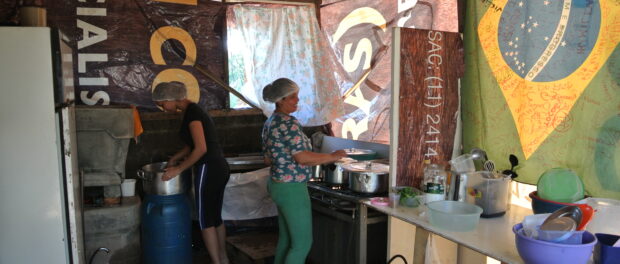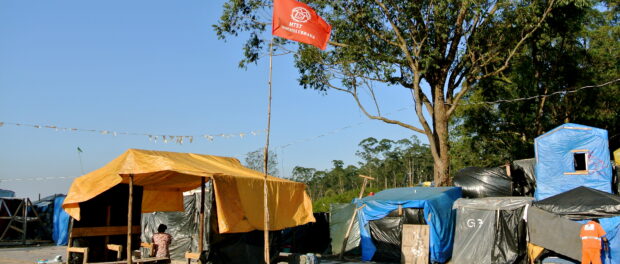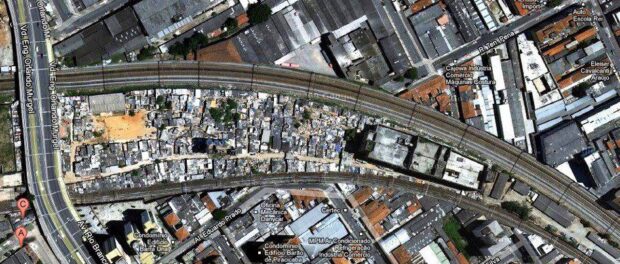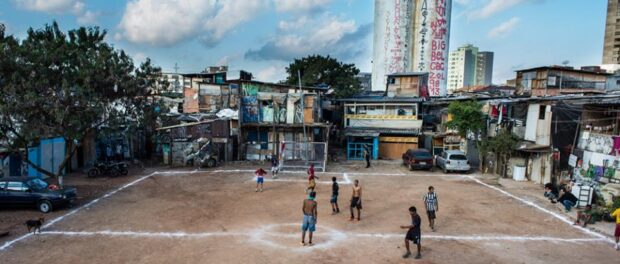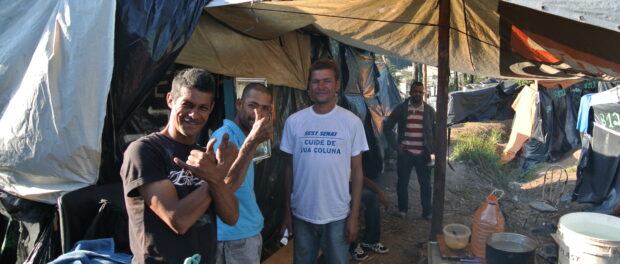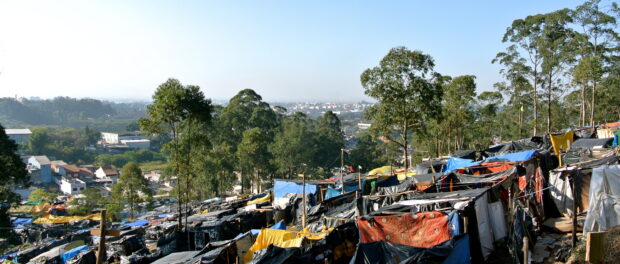
Thousands of families in São Paulo have been driven out of their homes due to extreme rent hikes. Since 2008, the average rent has risen by 97%, with average inflation in the city at 40%, making it impossible for many families, especially those of low income, to keep living at the heart of the city.
Families have been forced to move to distant peripheral neighborhoods where infrastructure is often precarious. Many workers face long daily commutes as a result. Everyday a population equivalent to that of Uruguay commutes from the east zone of the city to the center, nowadays all but “cleansed” of informal and low-income housing.
It is estimated by URBEM and others that by 2024 over 700,000 “first level” low-income housing units (for those earning zero to three times the minimum wage) will have to be built to address the housing deficit in the city. Currently, the Municipality of São Paulo has plans to build less than half of this.
Yet from land occupations to favelas resisting removal, many have taken it upon themselves to fight the city’s imminent housing crisis, and the struggle for fair living conditions is underway.
Occupation
Only three kilometers from São Paulo’s new billion dollar World Cup stadium, the aptly named Copa do Povo–People’s Cup–is a two month-old occupation of 5,000 families. In the eastern neighborhood of Itaquera, this sea of makeshift huts–thousands of them–is built out of stretched garbage bags, nylon sheets and wooden poles. The residents are mostly locals hit hard by real estate speculation. The occupation of the terrain, left vacant by a construction company, was organized by the MTST, the Homeless Workers’ Movement.
A social movement at the forefront of struggles for adequate housing in the city, MTST has organized numerous large-scale land occupations across São Paulo, with the intention of pressuring the government into building social housing and controlling rents in areas most affected by rent hikes. Some 15,000 families live in MTST occupations in São Paulo.
In the traditional working-class neighborhood of Itaquera rent prices have risen by as much as 50% since the building of the stadium in the area was announced.
“The World Cup brought increased value to the area, creating new jobs and possibility for infrastructure,” says Josué Rocha, one of the MTST’s São Paulo coordinators, “but as there is no rent control, residents have seen rents rise a lot and many are in need of new housing options.”
Local residents Joice Santos, 42, and Edna Batista, 41, moved to the occupation full-time with their teenage daughters, working as volunteers in the communal kitchen to provide free meals for the other residents.
“I love being here,” said Joice, who moved to the Copa do Povo after being priced out of her nearby two-bedroom flat, which rose from R$200 a month to R$450. Edna was previously homeless after being evicted from another occupation.
The MTST’s model of occupation is not to create an organic, permanent residency but to force negotiations with the government for the creation of Minha Casa, Minha Vida (MCMV–My House, My Life) social housing on the occupied land. MTST have also organized large-scale protests in São Paulo, numbering as many as 25,000 people.
In the immediate build-up to the World Cup, the MTST successfully negotiated the transformation of Copa do Povo into social housing for those occupying it. Organized through the participatory Entidades stream of the MCMV program, at the MTST’s demand, future residents will be able to develop the plan for the housing to be built.
“It’s the result of a lot of struggle, and thank God. We are so excited, it’s such a big relief,” said Joice. “With the money I would be using to pay rent, I will be able to give [my daughter] a better life.”
Despite the success of the Copa do Povo, the future of other MTST occupations hangs in the balance. The 6,000-strong occupation Portal do Povo, on the site of a former favela in the wealthy neighborhood of Morumbi, is facing imminent eviction after the Military Police gave the occupiers 15 days to leave.
“Channels of communication [with the state] are carved out on the basis of struggles and mobilization,” said Josué. “But the criminalization of social movements hasn’t stopped.”
Resistance
Some 40 kilometers away, Favela do Moinho stands out as the only remaining favela in the city center. Squashed between two train lines and an overpass, the community has resisted repeated attempts at removal over the course of its 20-year history. Since 2009 removals in Moinho have been suspended pending a judicial process.
Soon after the ruling, in 2011 and 2012, Moinho was the scene of two suspicious fires that destroyed over half the community. More than 700 families were forced to leave after their homes were burned down, and now only 500 remain.
According to Alessandra Moja, activist and former residents’ association president, the government’s game is one of “omission” after repeated attempts to remove the favela proved useless. The fires are still a traumatic and controversial subject for the community. What remains of Moinho is surrounded by the rubble of the homes that were destroyed.
Alessandra has strong suspicions about the incident.
“The building [from which the first fire started] was brick and concrete, and who lives here knows there were not enough combustibles for it to catch fire like it did.”
Despite its proximity to one of the richest neighborhoods in São Paulo, Moinho does not receive basic government services. There is no sanitation, water or electricity. As many as half of the houses are built out of plywood.
Antonio Silva has lived in the community for 18 years and his house was burned down in the first fire.
“Everything was lost,” he said.
He and his wife moved into the bar he owns in another area of the community. He had to close the establishment as a result.
“We were able to come here, but many others were left homeless, sleeping on the floor around us.”
Those who were left homeless were eventually placed into the Bolsa Aluguel (social rent) program. The monthly help of R$400 was not enough to pay the rent in Favela do Moinho which forced the residents to move even further away from central São Paulo.
Other favelas in São Paulo have fallen prey to efforts for removal. Favela do Buraco Quente in Morumbi was removed to make way for a mono-rail to Morumbi stadium, initially selected to host the World Cup games. When the building of a new stadium was announced in Itaquera, the project was abandoned.
During his 2012 electoral campaign current mayor Fernando Haddad promised to upgrade Moinho. There has been no work done toward this so far. In 2013, the Municipality agreed to participate with the residents in developing a plan for upgrading. This attempt at communication fell flat when government officials stopped attending meetings and responding to phone calls soon after.
In January 2014, a municipal representative came to the community with another upgrading proposal, this time asking the residents to sign an agreement to leave after an unspecified deadline.
“But you’ll make sewers, electricity, and water for who then, if we have to agree that we’re going to leave?” she said.
“We want the community to be upgraded, we want the families to be able to decide for themselves what they want. That everyone can have water, electricity and sanitation–this is a right of theirs, and a duty of the Municipality.”
In face of this neglect, residents of Moinho have taken it upon themselves to continue building the community. They recently won a grant to develop their own upgrading projects, and plans are underway to begin building a football pitch and plant trees.
Alessandra and two others underwent training as civil fire fighters, lest any more fires appear.
Reclaiming the City
The Prestes Maia building, an abandoned 22-story block in the central Luz neighborhood is currently the highest squatted building in the world. Some 500 families have been occupying the space for several years. Like Moinho, it has been under constant threats of removal.
As these popular and informal communities are eroded by aggressive real estate policies and speculation, São Paulo continues to expand outwards, with the city’s poor forced ever further away into new peripheries–only to be forced to commute back on a daily basis.
Despite this, large swathes of the former industrial center lie abandoned. According to architect Milton Braga it is estimated that 300,000 people moved out of the city center–voluntarily or not–as part of this migration.
Nowhere is the corrosive nature of this process more apparent than in the construction of social housing (part of the MCMV program) in the peripheries of São Paulo which lack adequate infrastructure.
The MTST is highly critical of the MCMV program.
“We know that in general MCMV has not resolved the problem of popular housing,” says Josué.
The MTST argue that the current format of the program encourages poorly built houses on cheaper, distant land. Contractors receive a fixed amount from the federal government per housing unit built which encourages fast building for profit.
Another issue pointed out by MTST is that the majority of MCMV resources are destined for people earning over three minimum wages, when the majority of the deficit is of those earning less.
“We fight so that the appropriate infrastructure will be available [along with housing]–for health, a nursery, a larger school in the area,” says Josué.
Architect and professor of Architecture and Urbanism at São Paulo University Milton Braga is also critical of the Brazilian model of social housing.
“Social housing is very badly done. We don’t build neighborhoods,” he says,“ [but rather] deposits of people, far from urban life, and always in the peripheries–without imagination and without care.”
Milton works for URBEM (Institute of Urbanism and Studies for the Metropolis), an institution that has created a series of proposals for the re-urbanization of the city center in response to Brazilian social housing.
URBEM want to encourage investment in mixed-income housing to avoid “ghettoization” and foster the development of the necessary infrastructure to create a fully-functioning “neighborhood” where people can live, work and reach services in their local area.
This will, as he puts it, “make it so that Uruguay does not have to come to the center every day, but only when they want to.”
Obligations
The almost incomprehensible size of São Paulo is an indicator of the scale of the housing crisis its residents are facing. As costs of living continue to rise, specialists say the problem will only get worse.
As the federal, state and municipal governments fail to take the necessary steps to address the root causes of the issue, or provide adequate solutions, popular communities have taken the matter into their own hands.
The popular movement for creative solutions continues to grow, pressuring the state into fulfilling its duties in providing adequate residency for them, rather than following the logic of speculation and profit.
Beyond simply a roof and four walls, the development of adequate living conditions is essential to the functioning of the city, from transport to health and security.
“Brazilian cities will not work without addressing the housing issue,” concluded Milton.

